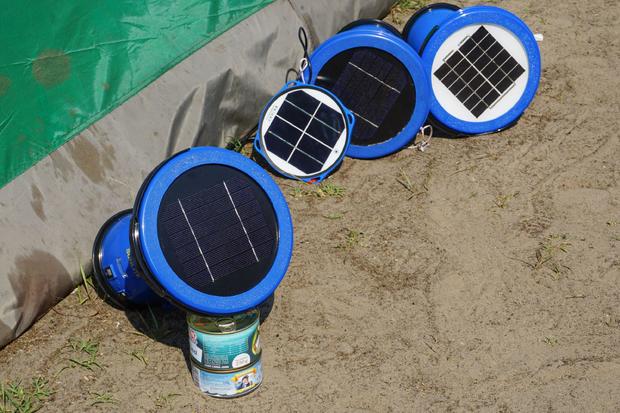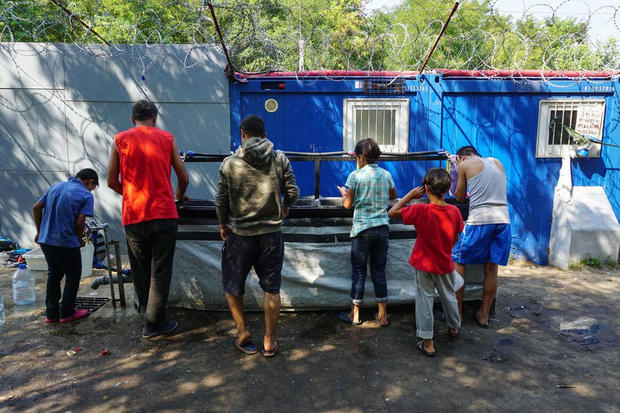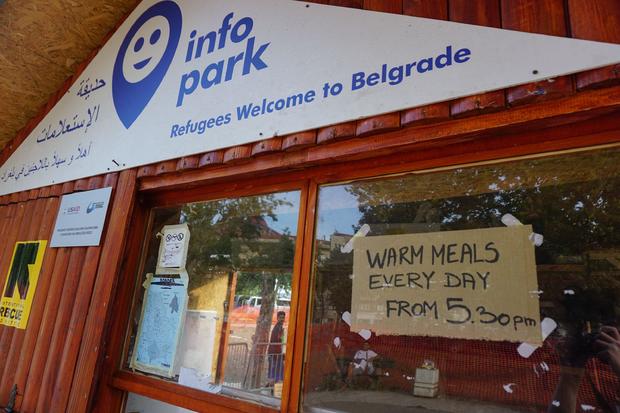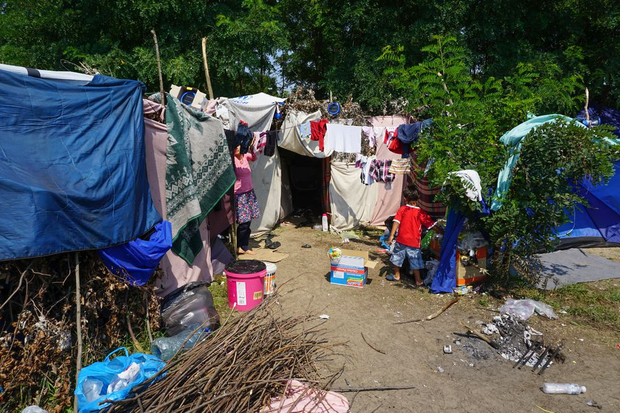For refugees on Hungary's border, razor wire trumps tech
Sayed Mohsen Shah isn’t like other refugees in the Horgos camp. Every night, the former Afghan merchant, who speaks five languages, hands his bulky portable battery charger to Serbian authorities. Every morning, they give it back, fully charged.
It’s the only way the government can reliably reach the democratically elected leader of the 400 to 600 migrants living in this dirty, makeshift camp in Serbia, literally next to the border with Hungary. And it’s the only way Shah can regularly power his Samsung J5 phone in a place with no electricity, no Wi-Fi and no showers.
“They know, if my mobile is off, I cannot call them,” says Shah, showing us his shiny black G-Cool-branded charger in the hot August sun. The air hums with the sound of semis idling at the customs checkpoint 500 feet away.
Shah is lucky. As camp leader, he gets special privileges, like free charging. But everyone else stuck in this no-man’s land has to make do with USB chargers attached to solar lamps, which fizzle out by the time a phone’s power hits just 10 percent. Dedicated solar phone chargers dot the tent labyrinth, but they’re contraband. Many of the refugees and migrants here -- mostly young, single men from Afghanistan -- walk to a shop or gas station up to an hour away, hoping that buying a coffee or snack will win them access to a power outlet. Sometimes they succeed. Most times they don’t.
This is life on the Hungarian-Serbian border in 2016. We traveled to Hungary and Serbia last month to see technology’s impact on the thousands of people who ended up here after running for their lives from places like Afghanistan, Syria and Iraq. Some are stranded in Horgos because they mistakenly thought they could still travel the shortest path between Greece and Germany, which remains open to refugees even as some countries, including Hungary, have closed their borders. Horgos lies directly on that path, known as the Western Balkan Corridor.
We found that the technological aid most of us take for granted is often hamstrung by political opposition, by refugees’ maddeningly complex predicaments or by their unfamiliarity with tech.
“If they have access to technology, to Wi-Fi, to a smartphone, that could help them immensely,” Babar Baloch, a spokesman for the United Nations High Commissioner for Refugees, told us. His UN arm published a report Wednesday that talked about the importance of mobile connectivity as a lifeline. “It’s actually a matter of life and death.”
Steel blockade
Last year, more than 1.1 million refugees and migrants fled to Europe. They save up to buy phones if they don’t already have one so they can find their way on their long journey, discover support services using social media and access news on apps and websites.
In Horgos, the lack of tech is stunning.
Shah ticked off modern-day staples missing from this cluster of tents ringed by wind-blown trash. Showers are a wood pallet in the dirt shrouded on four sides by blankets and broken branches. Electricity is limited to blue, plastic Sunlite solar-powered lamps, which were permitted by border authorities only this summer. Before then, people were left in darkness at nightfall. Wi-Fi access rolls into Horgos most mornings thanks to a Serbian Red Cross truck that doubles as a mobile hotspot. The free wireless network disappears an hour later when aid workers drive away.
What this part of Europe does have is a fence. A big one. Topped by razor wire, the fence stands 10 feet high and stretches 181 miles along the Hungary-Serbia border and part of Hungary’s border with Croatia. Hungary completed the Serbian leg last September and the Croatian section in October.
Headed by Prime Minister Viktor Orbán, Hungary’s right-wing government built the fence along its southern borders to stop migration after hundreds of thousands of people came through the country to get to Germany.
It’s working.
From July through September 2015, more than 140,000 people -- as many as 12,000 daily -- crossed into Hungary from Serbia, according to the EU border agency Frontex. On September 15, the day Hungary completed its fence, the country detected 9,000 illegal crossings. The next day, when Hungary finally sealed the border, there were 410. Climbing through the fence or damaging it is a criminal offense punishable by imprisonment.
Orbán, who has called migrants a “poison,” boasts that the border is now “hermetically sealed.”
Denial of service
Technology has different meanings on the border, depending on which side of the fence you’re standing.
The Horgos camp enjoyed a technological breakthrough last month when an aid organization jury-rigged a system of plastic pipes that turned the single spigot of running water into five. On the Hungarian side, meanwhile, a window air conditioner cools the offices of those working in the transit zone between the two countries. Up to 6,000 military, police and civilian militia known as field guards monitor the border with helicopters and advanced tech including thermovision cameras and handheld night-vision devices.
Field guards included a force from Asotthalom, a village led by mayor László Toroczkai, who uses YouTube to distribute a staged, action-movie-style trailer set to heart-pounding music. Men in camouflage speed down dirt roads on motorcycles and SUVs, while the camera soars above them in a helicopter. A two-minute video that tells migrants they’re not welcome in Hungary has been viewed nearly 2 million times.
And where refugees turn to Facebook to find potentially life-saving information, Toroczkai posts images that hint at what it’s like for migrants seeking passage through a country that officially repels them. A cluster of young men crouch in the darkness, lit by the sideways cast of automobile headlights. “Tracking by night...” a caption reads in Hungarian, a one of two field guards clutches a night-vision scope in his hand. Three men, hands bound behind their backs by zip-tie cuffs, lie face down in the dirt.
That attitude partly explains why the government hinders migrants’ access to even the most basic tech at the Horgos camp. Shah says efforts to bring electricity, more solar chargers and showers are waiting for a “green light” from Hungarian officials and Serbia’s Commissariat for Refugees.
“I don’t know who has the say about this, why you cannot have these things here,” he tells us in a measured tone. “Only I hear they are not allowing to do this here, because this place is not the camp. It’s a border.”
Orbán’s cabinet office didn’t directly address claims it was holding back improvements. But it did say, in a statement, that the government provides food packages every day to people staying outside its transit zones and gives financial aid to charities that help “crisis situations” at the border.
Mis-Info Park
Belgrade is a two-hour drive from Horgos. In the center of Serbia’s capital, a park has become another de facto camp for refugees. So much so that Google Maps temporarily labeled it “Afghan Park” when we visited last month.
Flimsy, orange plastic fences surround packed dirt patches where there once was grass. The barriers were constructed the month we arrived, purportedly so the government could reseed the lawn. The city’s main bus station borders the area, actually called Bristol Park, and we can see Serbs dragging heavy luggage as they board coaches bound for vacation spots like Budapest and Croatia.
Behind the station we find about 500 refugees, mostly single men. They roll out blankets or scavenged cardboard as cushions against the hard dirt and concrete, and hang their clothes to dry on rope stretched between poles. Unlike Horgos, there are no tents or public sanitation, aside from an attendant-manned toilet at the bus station, which costs 50 dinar (45 cents) for each use.
But there’s free Wi-Fi from Telenor, which the men can log onto to watch YouTube videos or check Facebook while they wait for dinner to be distributed at Info Park, an aid center within Bristol Park that opened the day Hungary fenced its border. The first 270 in line get a meal — penne with tomato sauce and a salad of lettuce and tomato was served the night we visited — promptly at 5:30 p.m. That evening, about a dozen refugees plugged their phones into power strips connected to Info Park’s office in a no-frills wooden cabin.
Every so often, word comes that Hungary is opening its border for a few days. The men hurriedly pack their belongings, sell or trash what they can’t carry and run for Horgos. But as the aid workers in the park know, Hungary isn’t opening its border. If anything, the country is doing more to secure the area. Last month, Orbán announced plans to build a second, massive fence along the Serbian border. The government has also talked about extending the fence across its border with Romania.
Still, desperate refugees won’t risk missing an opportunity to cross the border if there’s the slightest chance the rumors are true.
“Before we could do a lot more for them,” Irena Vari, a recent college grad who volunteers at Info Park, tells us. A child of refugees herself from the Bosnian war in the 1990s, Vari majored in Arabic at Belgrade University, never imagining how useful it would become.
“We could provide them with clothes, shoes, food and put them on a train, and we knew that in a few hours they were going to cross the border and they’re going to go their way,” the 22-year-old says, closing up shop at Info Park as daylight fades. “But now there’s not much we can do. They’re left with smugglers. They’re stuck. They’re frustrated. We don’t know what to advise them.”
Reaching Hungary
It’s a different world, a year after the big surge of refugees arrived in Europe seeking shelter. Some of the apps and other tech that worked last September aren’t relevant today.
Take the InfoAid app. Choreographer Nina Kov and her husband spearheaded the app’s development to relay real-time details in seven languages to migrants and refugees passing through Hungary.
At the peak of the influx, Kov — who had no app-making experience — said she worked day and night with developers in Denmark, Austria and Romania to give straightforward information to people flooding through Hungary. But since the refugee stream is blocked at the border, work on the app has slowed to a trickle. Kov is now the only person posting in English, Hungarian and (with assistance) Arabic.
“No [refugees] in their sane minds want to be here,” she says about the anti-refugee stance taken by the government in Hungary. “We had to adapt when it’s less active than it was.”
About 1,200 refugees live in Hungary’s official reception and detention centers, according to the United Nations. (The government hasn’t allowed any members of the press to enter the centers.) Refugees there have access to the Internet, but the realities of the centers sometimes make that challenging.
Lilla Zentai, who coordinates social work at the Hungarian aid organization Menedék, has visited the Vámosszabadi reception center near Hungary’s northern border with Slovakia. Wi-Fi is available to asylum seekers there, but she says the signal is very weak. People cluster in the corridor around the router, standing on chairs to try to send a message.
“That Wi-Fi is enough to contact a trafficker; it’s not enough to search for a house or a job,” she says. Such conditions discourage people from staying in Hungary, she tells us. She suspects that’s the goal.
Orbán’s cabinet office said it “firmly rejects” allegations that asylum seekers have limited access to the Internet. The Vámosszabadi center has an Internet room and “sufficiently strong,” continuous Wi-Fi, the government said. But it did concede connectivity will degrade if hundreds of people try to access the network.
“Mustii,” a 27-year-old refugee from Afghanistan, lived in two Hungarian reception centers for six months before settling in Budapest when he received asylum. (He asked that we not photograph him and that we refer to him by his Hungarian nickname.)
Mustii says refugees at the reception centers, where people could come and go freely, head into the city to buy a Telenor Hungary SIM card. One gigabyte of phone data access for one month costs 1550 Hungarian florint, about $5.50.
Tech literacy
Like Shah, Mustii is special. He worked in IT in Kabul, and spoke five languages including English when he arrived in Hungary. Many of the people he met in the camps don’t come close to his level of technological literacy. Refugees in the first waves of migration into Europe last year tended to be like Mustii and Shah — educated, middle class and resourceful. Migrants streaming to Europe this year often had less access to technology in their day-to-day lives, even before they fled conflict.
“They’re poor people,” Mustii said. “They don’t know how to use the apps of the mobile. They just know how to dial the phone, how to call. That’s all.”
That tech illiteracy makes it difficult for aid organizations to help them.
Inside this tent is a one-week-old baby boy. The women in the Horgos camp do all they can to make their tents clean -- a futile task in an area covered in dirt and grime.
The Hungarian Helsinki Committee, for example, has begun documenting claims of abuse by police, military and vigilantes at the border. It hoped going digital with a Google questionnaire would streamline the documentation process and help it gather evidence. Since May, it has collected about 350 reports of brutality, such as beatings and pepper spray use. But by early September, only seven online forms recounted details from 24 victims.
The form is available only in English, and people without Internet access can’t fill it out. Getting volunteers to precisely document the information from people who were injured isn’t easy, either. So the Hungarian Helsinki Committee wants to reduce the number of questions and make the form simpler.
“It’s not an easy task, and also this is something the Hungarian Helsinki Committee never had to do before,” says Andras Lederer, information and advocacy officer for the organization’s refugee program. “This sort of violence and brutality is completely new to this country.”
The Hungarian government rejects the Hungarian Helsinki Committee’s allegations of mistreatment. It said in a statement that “it conducts police actions by observing the principles of legality, professionalism and proportionality, in particular with regard to carrying out actions involving illegal migrants in a humane manner and by respecting their human dignity.”
The Hungarian Helsinki Committee is also working on an iPad app to make it easier to communicate with refugees being held in detention centers. Hungary is one of the few European states that regularly detains first-time asylum seekers for several months, the groupsaid.
Language barriers and overcrowding make it impossible for counselors to spend enough time with each person. The iPad app would work in 10 languages to gather information, like “I was here, I want to go there,” “I need medical treatment,” or “My passport has been taken from me.”
Building the app isn’t easy or cheap. It has to be as simple to use, and accurate and informative. It also needs to speak the options for those who can’t read. Since the Hungarian Helsinki Committee has a limited budget, it needs people with strong language skills who are willing to donate their time. But if the app works, the group can do more to help.
“There are people from several dozen countries in one large detention facility,” Lederer says. “Think about how many interpreters you need to be able to provide true counseling.”
“We are human”
Three days after our visit to Info Park, the aid group gets word the Serbian government may eject them. It wants to clear the area of migrants and send them to a camp in Krnjaca, a neighborhood on the outskirts of Belgrade. The group’s attorneys are fighting eviction.
“Our hut is still standing, but we don’t know for how long,” Vari tells us over email early this month.
Back at the Horgos camp, Shah, who hopes to meet up with his family in Germany, points to places where humanitarian improvements should go. See that cleared patch of uprooted soil, past the tent with the one-week-old newborn? That’s where the real showers should be, if government authorities ever approve them.
“We are human. And we are, I think, in the 21st century, I am right?” the soft-spoken Shah asks thoughtfully. But Shah punctuates his next sentence like it was a wad of something bitter he wants to spit out.
“In the 21st century, humans are living in the jungle — and we are waiting for a shower.”
This story originally appeared on CNET.




